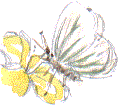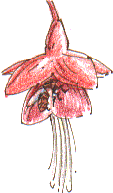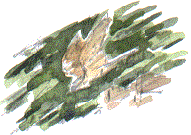Nature Diary
Rocks
History
Gallery
Links
Home Page
 A GREEN-VEINED WHITE goes from one flower to another in the patio tub, in a more random fashion than a bee would, moving from yellow to purple Pansies, then breaking off to sample the Alyssum. Its long tongue has a kink in it, like a plastic drinking straw. It inserts it with precision into the pin-hole at the centre of each flower.
A GREEN-VEINED WHITE goes from one flower to another in the patio tub, in a more random fashion than a bee would, moving from yellow to purple Pansies, then breaking off to sample the Alyssum. Its long tongue has a kink in it, like a plastic drinking straw. It inserts it with precision into the pin-hole at the centre of each flower.
 Fuchsias don't seem to be designed for bees. The entrance to the flower is an assault course. Stigmas and stamens hang down like Tarzan ropes. I've noticed that honey bees climb on the 'skirt' of the flower and push around under the overhanging sepals. Perhaps there is a 'back entrance' to the nectaries here. Or perhaps some insect has cut a way in, as a shortcut to the nectar. I watch one bee as it visits two flowers by the 'back door' then climbs the stamens of a third.
Fuchsias don't seem to be designed for bees. The entrance to the flower is an assault course. Stigmas and stamens hang down like Tarzan ropes. I've noticed that honey bees climb on the 'skirt' of the flower and push around under the overhanging sepals. Perhaps there is a 'back entrance' to the nectaries here. Or perhaps some insect has cut a way in, as a shortcut to the nectar. I watch one bee as it visits two flowers by the 'back door' then climbs the stamens of a third.
 You could set your clock by that Sparrowhawk. This is the second day that it has swooped into the garden at noon*. Once again the fantail pigeons fly off, the hens screech and the House Sparrows behave like car alarms. I get a stereo effect as they make repeated alarm calls from one to the other, hedge to hedge. The call has a more urgent ringing quality than their usual chirupping. At the start there are twenty or more of them at it. Then things calm down and it becomes spasmodic. Finally there are two of them left, the most alarmist of the flock, batting back the call, with less and less conviction, from one to the other.
You could set your clock by that Sparrowhawk. This is the second day that it has swooped into the garden at noon*. Once again the fantail pigeons fly off, the hens screech and the House Sparrows behave like car alarms. I get a stereo effect as they make repeated alarm calls from one to the other, hedge to hedge. The call has a more urgent ringing quality than their usual chirupping. At the start there are twenty or more of them at it. Then things calm down and it becomes spasmodic. Finally there are two of them left, the most alarmist of the flock, batting back the call, with less and less conviction, from one to the other.
 By the time their calls peter out, three or four minutes later, the sparrowhawk will be be well on its way, probably following a regular beat through the gardens.
By the time their calls peter out, three or four minutes later, the sparrowhawk will be be well on its way, probably following a regular beat through the gardens.
 A young newt, or eft, to give it the name that is so useful in crosswords and in Scrabble, swims amongst the pondweed. Its small legs are growing but it still has feathery gills fanning out at the back of its head.
A young newt, or eft, to give it the name that is so useful in crosswords and in Scrabble, swims amongst the pondweed. Its small legs are growing but it still has feathery gills fanning out at the back of its head.
* I think of midday as the time when the sun climbs to its highest point in the sky and the shadows are shortest. To make the most of the longer hours of daylight at this time of year under British Summer Time (or is that British Standard Time?) twelve noon becomes 1 p.m.. Someone was telling me that this year BST will be retained through the winter too. If so, that will mean noon at 1 p.m. every day.

Richard Bell,
wildlife illustrator
E-mail; 'richard@daelnet.co.uk'
Next page
Previous day
Nature Diary
Wild West Yorkshire home page
|
 A GREEN-VEINED WHITE goes from one flower to another in the patio tub, in a more random fashion than a bee would, moving from yellow to purple Pansies, then breaking off to sample the Alyssum. Its long tongue has a kink in it, like a plastic drinking straw. It inserts it with precision into the pin-hole at the centre of each flower.
A GREEN-VEINED WHITE goes from one flower to another in the patio tub, in a more random fashion than a bee would, moving from yellow to purple Pansies, then breaking off to sample the Alyssum. Its long tongue has a kink in it, like a plastic drinking straw. It inserts it with precision into the pin-hole at the centre of each flower.
 Fuchsias don't seem to be designed for bees. The entrance to the flower is an assault course. Stigmas and stamens hang down like Tarzan ropes. I've noticed that honey bees climb on the 'skirt' of the flower and push around under the overhanging sepals. Perhaps there is a 'back entrance' to the nectaries here. Or perhaps some insect has cut a way in, as a shortcut to the nectar. I watch one bee as it visits two flowers by the 'back door' then climbs the stamens of a third.
Fuchsias don't seem to be designed for bees. The entrance to the flower is an assault course. Stigmas and stamens hang down like Tarzan ropes. I've noticed that honey bees climb on the 'skirt' of the flower and push around under the overhanging sepals. Perhaps there is a 'back entrance' to the nectaries here. Or perhaps some insect has cut a way in, as a shortcut to the nectar. I watch one bee as it visits two flowers by the 'back door' then climbs the stamens of a third. You could set your clock by that Sparrowhawk. This is the second day that it has swooped into the garden at noon*. Once again the fantail pigeons fly off, the hens screech and the House Sparrows behave like car alarms. I get a stereo effect as they make repeated alarm calls from one to the other, hedge to hedge. The call has a more urgent ringing quality than their usual chirupping. At the start there are twenty or more of them at it. Then things calm down and it becomes spasmodic. Finally there are two of them left, the most alarmist of the flock, batting back the call, with less and less conviction, from one to the other.
You could set your clock by that Sparrowhawk. This is the second day that it has swooped into the garden at noon*. Once again the fantail pigeons fly off, the hens screech and the House Sparrows behave like car alarms. I get a stereo effect as they make repeated alarm calls from one to the other, hedge to hedge. The call has a more urgent ringing quality than their usual chirupping. At the start there are twenty or more of them at it. Then things calm down and it becomes spasmodic. Finally there are two of them left, the most alarmist of the flock, batting back the call, with less and less conviction, from one to the other. By the time their calls peter out, three or four minutes later, the sparrowhawk will be be well on its way, probably following a regular beat through the gardens.
By the time their calls peter out, three or four minutes later, the sparrowhawk will be be well on its way, probably following a regular beat through the gardens.